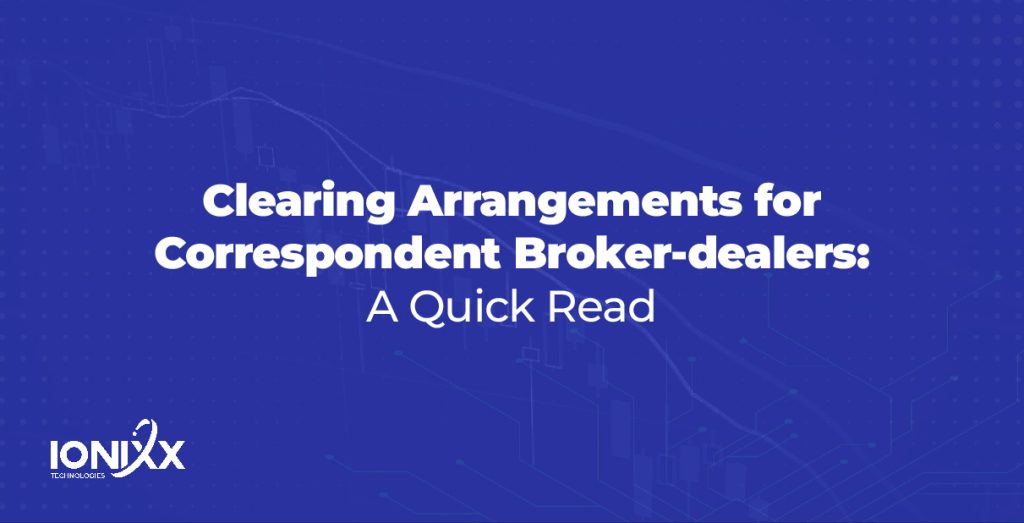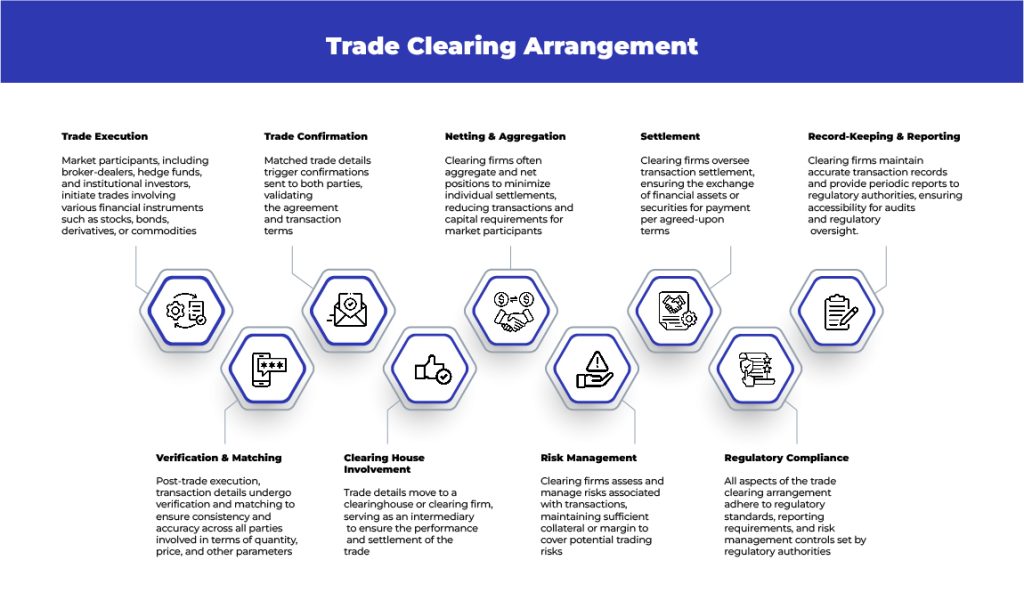
Broker-dealer clearing arrangements elaborate how introducing broker-dealers and clearing firms manage trade settlements, asset custody, and back-office functions in the financial industry.
Labeled the “firm clearing method,” it involves activities such as carrying accounts, holding funds and securities, and providing clearing services for a correspondent or introducing a broker-dealer. These arrangements are crucial for ensuring faster settlement, recording, and compliance with regulatory standards. The firm clearing method empowers correspondent or introducing broker-dealers to focus exclusively on customer relationships, sales, and front-end services while leaving the responsibilities of clearing and settlement functions to larger clearing firms.
Clearing Arrangements in Detail
There are two types of clearing arrangements: Fully disclosed and omnibus arrangements.
Fully Disclosed Arrangements
In a fully disclosed arrangement, the introducing broker sends trades to a clearing broker, DTCC, for clearance, settlement, and custody. The introducing broker will not have to be as responsible financially under the Securities and Exchange Act of 1934 (“Exchange Act”) capital rule, Rule 15c3-1, and the SEC financial protection rule, Exchange Act Rule 15c3-3.
“Fully disclosed arrangements” mean deals or relationships that are clear and open to everyone, especially regarding brokerage or trading. These agreements include fully disclosure of the roles, duties, and terms that were agreed upon by all parties involved in a financial transaction.
Omnibus Arrangements
An omnibus clearing firm consolidates the positions of introduced customers in a single account, managing both customer transactions of the introducing broker. While the introducing broker’s proprietary positions may also be included, proprietary transactions of the introducing broker are conducted in an account distinct from customer transactions.
The Importance of Correspondent Clearing Arrangement
The trade clearing process is a critical component in ensuring the seamless and efficient functioning of financial markets. Its role is pivotal in maintaining the accuracy, integrity, and compliance of financial transactions, thereby upholding market stability and investor confidence. As regulations, technology, and risk management practices continue to evolve, they significantly impact the effectiveness and security of the trade clearing process.
To understand the trade clearing process better, here are the steps involved in the process,
Trade Execution
The trade clearing process begins with the execution of trades by various market participants, including broker-dealers, hedge funds, and institutional investors. These entities engage in buying or selling financial instruments such as stocks, bonds, derivatives, or commodities.
Verification And Matching
Following trade execution, the details of the transaction undergo verification and matching by the involved parties. This step ensures consistency and accuracy in trade details, encompassing quantity, price, and other terms, across all parties engaged in the transaction.
Trade Confirmation
Trade clearing arrangements play a crucial role in processing, confirming, and settling financial transactions in the market. These arrangements are indispensable for guaranteeing the accurate, secure, and regulatory-compliant completion of trades executed by diverse market participants.

The Role of Clearing Firms in Trade Settlement
Clearing firms play a crucial role in the verification and settlement of trades executed by broker-dealers. This comprises trade confirmation, overseeing the exchange of securities for payment, and ensuring timely settlement.
Additionally, clearing firms commonly extend custody services, acting as custodians for securities on behalf of broker-dealers and their clientele.
Risk management is a key focus for clearing firms, involving the oversight and mitigation of various trading risks, including the maintenance of sufficient collateral or margin.
Significance of Regulatory Compliance And Risk Management Systems
Both broker-dealers and clearing firms are obligated to adhere to regulatory standards and reporting mandates established by regulatory bodies such as FINRA, the SEC, or CFTC.
Broker-dealers must meet specific financial responsibility requirements, including the maintenance of a minimum net capital level as dictated by regulatory rules. Clearing firms also carry financial obligations to ensure ample resources and compliance with regulatory requirements.
The responsibilities of clearing firms encompass maintaining accurate transaction records, submitting periodic reports to regulatory authorities, and ensuring consistent compliance with regulatory standards. In parallel, broker-dealers are tasked with maintaining their records related to customer accounts, transactions, and other requisite documentation.
Broker-dealers often leverage the infrastructure and capabilities of clearing firms to streamline trade settlements, reduce operational complexities, and delegate certain back-office functions effectively.
The Role of Regulatory Bodies in The Trade Clearing Agreements
FINRA
FINRA exercises regulatory oversight over its member brokerage firms, wielding authority in specific regulatory domains, including trading practices, compliance, and market integrity within the NYSE.
Rule 15c3-1
Carrying and Clearing Brokers play a direct role in executing transactions and holding customer funds and are subject to elevated financial responsibility requirements under Rule 15c3-1.
Rule 15c3-3
Carrying and Clearing Brokers manage customer funds and securities under stringent Rule 15c3-3 requirements for asset protection. Introducing Brokers, with less extensive Rule 15c3-3 obligations, are still under regulatory oversight, maintaining adequate capital for stability. SEC’s tailored requirements align with broker-dealers’ diverse roles, ensuring appropriate financial responsibility based on business activities and risk levels.
Wrapping Up
Broker-dealer clearing arrangements play a pivotal role in the seamless functioning of financial markets, facilitating trade settlements, asset custody, and back-office functions. Clearing firms and introducing brokers must collaborate seamlessly for efficient trade execution, customer relationship management, and trade settlement. This harmonious partnership ensures accurate transaction processing and compliance with regulatory standards and enhances overall operational effectiveness in the financial industry.
In response to the dynamic changes in regulatory requirements, ensuring a robust post-trade system becomes imperative. Ionixx offers comprehensive automated post-trade solutions that seamlessly integrate with your back-office operations. Our automated processes cover corporate actions, settlements, compliance checks, clearing, reconciliation, and reporting. Whether you seek to augment your existing back-office infrastructure or implement new clearing software, Ionixx is your trusted partner. Connect with us today.


